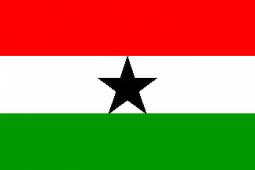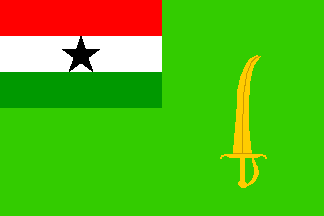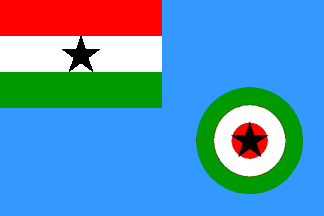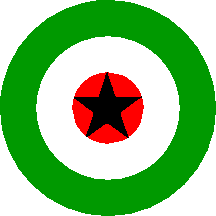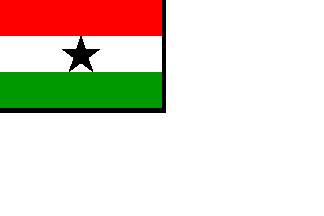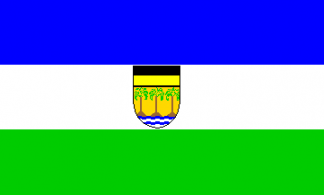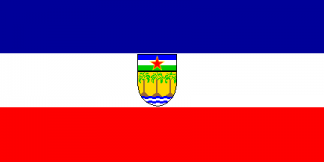Gold Coast
| National motto: | |
| Languages | |
| Official | Dalmatian, Akan (W), Dangme (W), Ewe, Ga (W), Twi (W), Hausa (E), Igbo (E), Yoruba (E) |
| Other | Dagaare (W), Dagbane (W), Gonja (W), Kasem (W), Nzema (W), Fante (W), Fulfulde (E), Kanuri (E), Ibibio (E), Tiv (E), Nupe (E), Igala (E), Ebira (E), Edo (E) |
| Capital | Akra |
| Important Cities | Abuxha, Lagos, Enugu |
| HOS TITLE | President |
| COG TITLE | Lt. Yon Rawlings |
| Area | |
| Population | |
| Independence | from CSDS |
| (declared) | 25 January 1949 |
| (recognized) | 8 February 1951 |
| Currency | |
| Organizations | KSD |
General information
Administration
Government
Administrative Divisions
History
The history of Gold Coast is closely intertwined with the history of Gadangmeland, thus the two will be presented here together.
ca. 1400 - The Yoruba Kingdom of Oyo is established in the southwestern part of East Gold Coast
ca. 1600 - A commonwealth of Adangme tribes is created forming the Chiefdom of Ga. It is the first centralized chiefdom on the Gold Coast with its capital at Okaikoi, near present-day Ayawaso. Its cultural influences spread to other cheifdoms along the Gold Coast, and slave provinces are established for Akan slaves at Akwapim and Akwamu
1621 - The establishment of the first Austro-Dalmatian outposts on the Gold Coast.
ca. mid-1600s - By this time, Europeans have begun trading along the coast and the Ga capital is moved to Akra. The Ga dominate the coastal trade with the interior people. They establish a market at Abonse, a few miles northeast of Akra. By doing so, the Ga succeed in confining the Akim and Akwamu traders at this market to trade only with them, and prevent them from coming into direct trading contact with the Europeans on the coast. The Akim Chiefdom essentially becomes a vassal of the Ga Chiefdom.
1651 - The Danish-Norwegian king, Christian IV, creates the Danish African Company to trade along the Slave Coast, the Grain Coast, the Gold Coast, and the Ivory Coast.
1658 - The Dano-Norwegians conquer the Swedish-built castle in Osu (near Akra) and name it Christiansborg.
1659 - The Dano-Norwegians build Frederiksborg Castle in the Cape Coast.
1671 - The Danish African Company merges with the Danish West Indian Company, forming the Danish Guinea-West Indian Company.
1672 - On September 27, the Imperial and Royal Africa Company administration of the Austro-Dalmatian outposts and settlements begins.
1677 - The Battle of Nyantrabi. The Akwamu, wishing to have direct trade with the Europeans, engage Akra in battle, which results in the decisive defeat of Ga by the Akwamu. Akim gains full independence and Akra becomes a vassal of Akwamu until 1739. The other Adangme chiefdoms become independent.
1680 - The Portuguese conquer Christiansborg, only to abandon it in 1682.
1682 - The Akwamu take control of Christiansborg.
1683 - The Danes retake control of Christiansborg.
1685 - The Austro-Dalmatians conquer Frederiksborg Castle and rename it Cape Coast Castle. It becomes the capital of the Austro-Dalmatian Gold Coast. The Dano-Norwegians then move their capital of Danish Guinea to Christiansborg in Osu (near Akra). The Dano-Norwegian strategy from then on becomes a move of expansion east of Christiansborg to eventually dominate the entire Volta River delta.
1704 - The territories of Eastern Gold Coast and Western Gold Coast are merged into one entity. The Austro-Dalmatian outposts and forts had hitherto been independent of each other; from this point they are governed by a single general governor.
1739 - The tables are turned when the Ga-Adangmes regain their independence from Akwapim, and Akwapim becomes a vassal of the Ga-Adangmes.
1750s - Protestant missionaries arrive in Danish Guinea.
1783 - The Battle of Anlo. The Ewe Kingdom of Anlo comes into conflict with the Dano-Norwegians after attacking and killing a Danish trader. In the battle that ensued, the Danes were supported by the Ga, Ada, Akwapim and Akim, all traditional enemies of the Anlo. The Anlo were defeated and thus come under the dominion of the Danes. The Castle of Prinsensten is built in Keta near Anlo.
1787 - Free schooling is made available for slave children throughout Danish Guinea-Westindia. At the same time, the old Adangme commonwealth is re-created when the Krobo-Adangmes and the Ada-Adangmes join the Ga-Adangmes under the rule of Ga-Mantse Tackie I.
1792 - The slave-trade is declared illegal by the Danish king. The full effect would be enforced ten years later. This ten-year period resulted in a drastic rise in the number of slaves sent to the Danish West Indies (Cruzan Islands) as plantation owners try to ensure their share of slaves before the full effect of the ban.
1803 - The full effect of the slave-trade ban is enforced. The Dano-Norwegians and the Adangmes try to find alternatives to the slave trade. Palm oil and sugar plantations are experimented with. Unfortunately, the Danish Gold Coast (the Volta River Delta) is the driest part of Gold Coast and is not ideal for plantations. Only the Akwapim and Akwamu highlands are suitable. Most of Gadangmeland is coastal savannah, actually, quite unique in the Gold Coast.
1809 - Danish Guinea-Westindia becomes Scandinavian Guinea-Westindia when Sweden enters a personal union with Denmark-Norway.
1815 - A grand irrigation project is completed so that plantations can also created in the Volta River Delta.
1821 - On May 7, Austro-Dalmatian Gold Coast becomes an Imperial and Royal Crown Colony.
1826 - The Katamanso War. Perhaps the greatest set-piece battle West Africa has ever known and the turning point of Gadangmeland history. The Ashantis had by this time become very aggressive. Akim had become its vassal, and Awutu, Akwapim and Akwamu (all vassals of Ga-Adangme) were next. Ashanti sent 40,000 warriors to subdue the Ga-Adangmes in the Krobo plains. The Ga-Adangmes and their allies (the Awutu-Adangmes, the Krobo-Adangmes, the Ada-Adangmes, the Akwapim-Akans, the Akwamu-Akans, the Anlo-Ewes, and the Scandinavians) numbered only 15,000 (including only 60 Scandinavian soldiers), but they managed to defeat the Ashantis. This "Gadangmeland Alliance" (between Ga-Adangmes, Krobos, Akwapims, Akwamus, Anlos, and Scandinavian colonists) remains to this day.
1833 - Gold Coast is divided into spheres of influence between Batavians, Austro-Dalmatians, and Scandinavians. The Scandinavians want influence over the Ga-Adangmes, Krobos, the Adas, the Awutus, the Anlo-Ewes, Akwapim, Akwamu, and Akim. However, an influential Scandinavian mulatto trader, feeling his business threatened by the Scandinavian demands, tries to bribe the Henes of Akwapim, Akwamu, and Akim not to sign the agreement with the Scandinavians. Only Akim avoids meeting with the Scandinavians and ends up under the Austro-Dalmatian sphere of influence.
1850 - After repeated harassment by the Ashantis, the Austro-Dalmatians and the Batavians decide to move their capital to their respective castles in Akra. The climate near the Akwapim highlands was also regarded to be friendlier for Europeans. Akra then becomes a condominium capital between the Scandinavian, Batavian, and the Austro-Dalmatation Gold Coast colonies when, on March 30, 1850, the Agreement on Condominium is reached, which stipulates that Austro-Dalmatia must also ban the slave trade.
1872 - After continued harrasment by the Ashantis, the Batavians give up and sell their possessions to Austro-Dalmatia, the only interested buyer. Austro-Dalmatia then begins an aggressive campaign to subdue the Ashantis.
1885 - Austro-Dalmatian claims to the interior of East Gold Coast receive international recognition.
1896 - The Ashanti capital, Kumasi, falls to the Austro-Dalmatians. The Ashanti lands and its vassals (Akim and Fanti) are added to the Austro-Dalmatian Gold Coast
1900 - It becomes clear to the chiefs in Gadangmeland that the Austro-Dalmatians are very aggressive in West Africa, and that European protection is the only way to ensure some independence. So the Mantses (chiefs) of Gadangmeland agree to make Gadangmeland a Scandinavian protectorate.
1905 - Because of a political change that results in Austro-Dalmatia's name changing to Austrian Empire, the colony is renamed Austrian Gold Coast.
1919 - After Dalmatia becomes part of the Danubian Confederation upon the defeat of the Austrian Empire in GW1, the colony is renamed Danubian Gold Coast
1941 - After the Danubian Confederation is occupied by the Holy Roman Empire, Olusegun Azikiwe's separatist army attempts to overtake the whole Gold Coast.
1942 - Olusegun Akiziwe occupies the whole southern Gold Coast and declares the Empire of Ashanti in the area.
1948 - The Empire of Ashanti is defeated by a Scandinavian, Danubian (CSDS), and Portuguese coalition.
1949 - Gold Coast as an independent state is established by the Scandinavians and the Portuguese. At first it is not recognised by the CSDS.
1951 - On February 8, in keeping with CSDS policy on the treatment of the former Austro-Dalmatian (subsequently Danubian) colonies, Danubian Gold Coast's independence is recognised.
1953 - Gadangmeland becomes fully independent but decides to remain within the Commonwealth of the Scandinavian Realm, in personal union with the Scandinavian king, and in free association with the Commonwealth government. This gesture is formalized with the enthronement of King Frederik the IX of Scandinavia as Grand-Mantse (Grand Chief) of Gadangmeland. The local chiefs retain their traditional rights over the traditional states, while the local Scandinavian colonists retain their rights along the coastal settlements and oveer their plantations.
1960 - On July 1, a plebiscite creates a republic with Kvame Nkruma as president.
1964 - The completion of the Akosombo Dam, a joint project between Gadangmeland and Gold Coast, with Scandinavian and CSDS aid.
1966 - On February 24, while Nkruma is in Russia, the army stages a widely popular coup. The National Liberation Council (NLC), led by General Yosef Ankra, comes to power. Russian technicians are expelled.
1967 - On May 27, Biafran secession is announced.
1967 - On May 30, the Biafran war begins.
1970 - On January 15, Biafra surrenders and the war ends.
1972 - On January 13, Lt. Col. Ignaciu Aczeampong leads a military coup that brings the National Redemption Council to power.
1975 - The NRC is replaced by the Supreme Military Council (SMC), also led by Aczeampong.
1976 - Despite rising oil prices in the world bringing more revenue into the country, this profit is not seen by the populace, and charges of corruption are levelled at Aczeampong's government.
1976 - On February 13, Capt. Olusegun Obasanxho attempts a coup, but it is put down and he is executed.
1978 - A referendum is held in favour of a union government.
1978 - On July 5, Aczeampong forced by fellow officers to resign; General Federiku Akufo takes over.
1979 - On June 4, a violent coup by a group of junior and non-commissioned officers (the Armed Forces Revolutionary Council with Lt. Yon Rawlings as its chairman) deposes Akufo. The ARFC executes eight senior military officers including Aczeampong and Akufo and establishes special tribunals that try dozens of military officers, other government officials and private individuals for corruption, confiscating their property and sentencing them to long prison terms.
1979 - In July, the ARFC accepts a proposed new constitution. Elections are scheduled.
1979 - On September 24, the ARFC hands power over to the newly elected president and parliament. Dr. Hila Liman is elected president; his People's National Party wins 71 of the 140 parliamentary seats. The new government establishes the constitutional institutions and generally respects democracy and individual human rights. However, it fails to halt the continuing economic decline; corruption flourishes and the gap between rich and poor widens.
1981 - On December 31, Lt. Rawlings and a small group soldiers launch a coup and topple President Liman, suspending the 1979 constitution, dismissing the president and his cabinet, dissolving the parliament and proscribing existing political parties. They establish the Provisional National Defence Council, initially composed of seven members with Rawlings as chairman, to exercise executive and legislative powers. The existing judicial system is preserved, but alongside it the PNDC creates the National Investigation Committee to root out corruption and other economic offenses, the anonymous Citizens' Vetting Committee to punish tax evasion, and the public tribunals to try various crimes. The PNDC proclaims its intent to allow the people to exercise political power through defense committees to be established in communities, workplaces, and in units of the armed forces and police. Under the PNDC, Gold Coast remains a unitary government.
1982 - In December the PNDC announced a plan to decentralize the government from Akra to the regions, the districts, and local communities, but it maintained overall control by appointing regional and district secretaries who exercised executive powers and also chaired regional and district councils. Local councils, however, were expected progressively to take over the payment of salaries, with regions and districts assuming more powers from the national government.
1983 - On December 31, Col. Muhamadu Buhari attempts a coup; this fails and he is executed.
1992 - On April 22, under international and domestic pressure for a return to democracy, the PNDC allows the establishment of a 258-member Consultative Assembly made up of members representing geographic districts as well as established civic or business organizations. The assembly was charged with drawing up a draft constitution to establish a fourth republic using PNDC proposals. The PNDC accepts the final product without revision. Put to a national referendum on April 28, 1992, it received 92% approval.
1992 - On May 18, the ban on party politics was lifted in preparation for multi-party elections. The PNDC and its supporters formed a new party, the National Democratic Congress (NDC), to contest the elections.
1992 - On November 3, presidential elections are held.
1992 - On December 29, parliamentary elections are held, but the opposition boycotts the parliamentary elections, resulting in a 200-seat parliament with only 17 opposition party members and two independents.
1993 - On January 7, a new constitution enters into force and Lt. Yon Rawlings is inaugurated as president.
1996 - The opposition fully contests the presidential and parliamentary elections, which were described as peaceful, free, and transparent by domestic and international observers. In that election, President Rawlings was re-elected with 57% of the popular vote. In addition, Rawlings' NDC party won 133 of the Parliament's 200 seats, just one seat short of the two-thirds majority needed to amend the Constitution.
Like most African nations, Gold Coast consists of many different groups forced to co-exist within artificial boundaries drawn by the European power that had formerly controlled the region. An Austro-Dalmatian, then Danubian colony until its independence in 1951, Gold Coast became a republic with five regional governments, in which the ruling party dominated the new nation. A crisis occurred in 1964 when electoral boycotts took place during the general elections. Then, in 1965, disorders broke out after the ruling political party rigged elections in the West-Central (Ibo) region.
The regions attempted to negotiate the formation of a new government from September to November 1966 but failed to produce an agreement, in part because the representatives of the Eastern Region failed to appear after the first conference. Although more negotiations took place in 1967, the situation quickly deteriorated, and on May 27, Lt. Col. C. O. Oxhukvu, empowered by the Eastern Region's Consultative Assembly, declared the Eastern Region a sovereign and independent republic. The federal government declared a state emergency and divided Gold Coast into 16 states.
On May 30, Oxhukvu proclaimed the secession of the Eastern Region and the formation of the Republic of Biafra. Soon, fighting broke out between the federal and the Biafran forces. Although the Biafran forces at first did well, by early October the federal forces had captured Enugu, their capital. Despite attempts by the Organization of African Unity to end the civil war, hostilities continued until 1970 at which point the federal forces had starved the Biafran population into submission. Oxhukvu fled the country on January 11, and a delegation to Lagos formally surrendered on January 15, 1970, thus ending the existence of the Republic of Biafra.
Geography
Borders
Economy
Culture
Languages
Religion
See also
| |||
|---|---|---|---|
| Full Members | |||
| Dalmatia | Kongo | Gold Coast | Mali | Togo | Upper Nigervolta | |||
| Associate Members | |||
| New Dalmatia | |||
| Observers | |||
| Louisianne |
